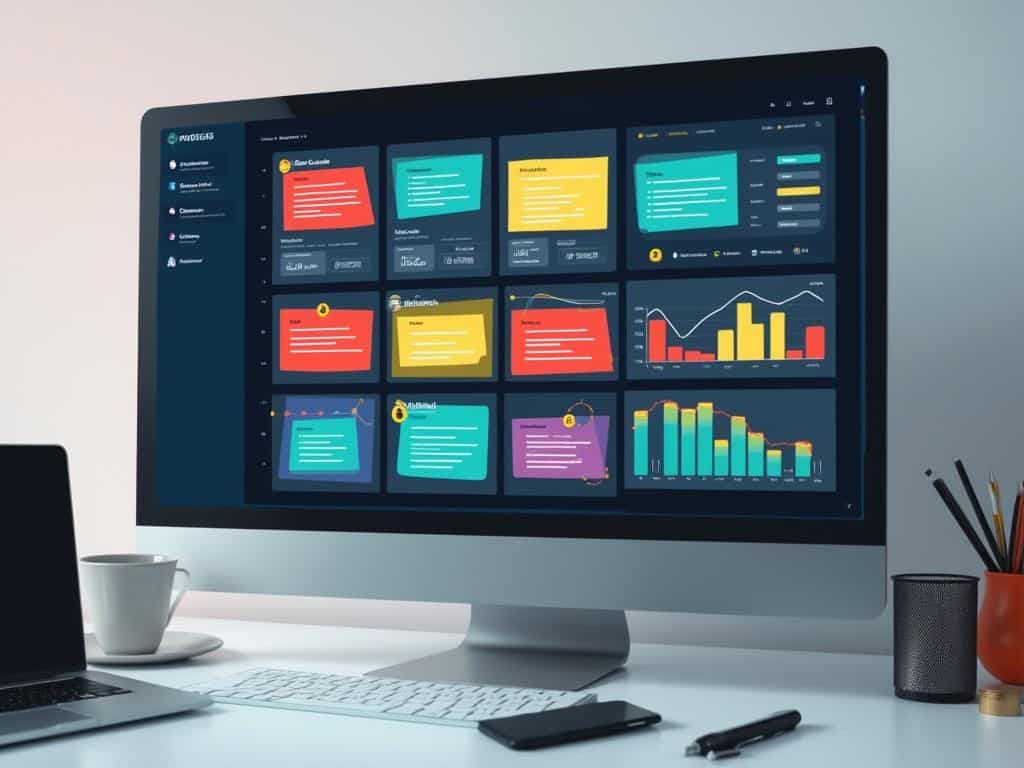
Transforming Team Collaboration with Project Planning Apps
Project planning apps like Trello, Asana, and Monday.com are transforming team collaboration and productivity, offering powerful tools that help organizations streamline workflows and complete tasks significantly faster. With the project management software market projected to reach $12.02 billion by 2030 and only 23% of organizations currently using dedicated project planning apps, these platforms represent a critical opportunity for businesses to enhance their operational efficiency.
Key Takeaways
- Cloud-based project planning apps enable teams to complete tasks 54% faster compared to traditional methods.
- Different industries are adopting project planning apps at varying rates, with technology leading at 67% adoption.
- Essential app functionalities include task tracking, collaboration tools, timeline visualization, and software integrations.
- Pricing models range from free tiers for small teams to enterprise solutions with advanced features.
- Security features like GDPR compliance and SOC 2 certification have become standard requirements for modern project planning apps.
Digital tools now define how teams track progress and manage tasks. The data clearly shows that companies using project management software gain significant advantages over competitors relying on outdated methods. These platforms cut through inefficiency by centralizing communication, automating routine processes, and providing real-time visibility into project status.
Teams across various sectors report completing projects faster and with fewer resources when using these specialized tools. Technology companies lead adoption rates because they recognize the competitive edge these applications provide in fast-paced markets.
You’ll find most quality project planning apps include essential features like customizable dashboards, file sharing capabilities, and detailed reporting functions. The best platforms also integrate seamlessly with other business software you already use.
Price points vary based on team size and feature requirements. Many platforms offer free basic versions for small teams or startups, while larger organizations typically invest in premium tiers that provide advanced analytics and security protocols.
“Embracing project planning apps like Trello, Asana, and Monday.com can revolutionize team collaboration, allowing organizations to complete tasks 54% faster while paving the way for enhanced operational efficiency. As the market for these powerful tools continues to expand, businesses that leverage them will unlock unprecedented potential in their workflows and productivity.”
Market Overview and Growth Trajectory
The project planning app market is experiencing explosive growth, with projections showing expansion from $7.24 billion in 2025 to $12.02 billion by 2030. This represents a Compound Annual Growth Rate (CAGR) between 10.67% and 15.7%, making it one of the fastest-growing software segments. Surprisingly, only 23% of organizations currently use dedicated project planning app solutions, indicating significant room for adoption.
Cloud-based project planning apps have proven their worth, enabling teams to complete tasks 54% faster than those without specialized tools. You’ll find these platforms particularly valuable when collaborating on complex projects with team members across different locations.
Several factors are driving this market expansion:
- Rising complexity in project management requirements
- Growth of remote and hybrid work environments
- Need for streamlined workflow optimization
- Demand for real-time collaboration capabilities
- Integration with existing business systems
The project planning app ecosystem has evolved beyond basic task management to encompass comprehensive solutions for teams of all sizes. Organizations implementing these tools report significant improvements in meeting deadlines and staying within budget constraints. When you’re integrating project management processes, having the right software becomes crucial.
Industry Adoption Patterns
Different industries are embracing project planning apps at varying rates:
| Industry | Adoption Rate | Primary Use Cases |
|---|---|---|
| Technology | 67% | Agile development, product launches |
| Marketing | 52% | Campaign management, content calendars |
| Construction | 43% | Site planning, resource allocation |
| Healthcare | 38% | Treatment protocols, facility management |
| Education | 29% | Curriculum development, research coordination |
The technology sector leads adoption, leveraging project planning apps to manage complex development cycles and cross-functional teams. Marketing departments follow closely, using these platforms to coordinate campaigns and content production. You’ll find scope creep prevention features particularly valuable regardless of industry.
For businesses just starting with project planning apps, the market offers solutions at various price points and complexity levels. Free tiers provide entry-level functionality for small teams, while enterprise solutions deliver comprehensive features for large organizations. When implementing a new project planning app, consider how it will help you track key milestones and coordinate team efforts.

Essential Functionalities of Project Planning Tools
Your project planning app needs specific core features to maximize team efficiency. A good project planning app combines task tracking, collaboration tools, timeline visualization, automation capabilities, and software integrations to streamline your workflow.
When selecting a project planning app, look for these must-have capabilities that differentiate professional tools from basic applications:
- File sharing with version control for centralized document management
- Email integration to reduce platform switching
- Gantt charts for visualizing project timelines and dependencies
- Time tracking to monitor productivity and manage billable hours
- Project budget management features to control costs and resources
Modern project planning apps must also prioritize security. GDPR compliance and SOC 2 certification have become standard requirements, ensuring your project data remains protected across all collaborators. This is especially important as effective project collaboration increasingly spans multiple departments and locations.
Flexibility and Accessibility Features
The best project planning app options offer flexibility in how you view and manage your projects. Different team members often prefer different visualization methods, so look for platforms that support:
- Kanban boards for visual workflow management
- List views for sequential task organization
- Calendar views for time-sensitive scheduling
- Timeline views for tracking dependencies
- Dashboard views for high-level progress monitoring
Cloud-based project planning apps enable teams to complete tasks 54% faster by providing anytime, anywhere access. This accessibility has become crucial with the rise of remote and hybrid work environments. Your project management tools should support real-time updates and notifications to keep everyone aligned regardless of location.
Integration capabilities also determine the effectiveness of your project planning app. Look for tools that connect with your existing software ecosystem:
- Communication platforms (Slack, Microsoft Teams)
- File storage (Google Drive, Dropbox, OneDrive)
- CRM systems (Salesforce, HubSpot)
- Development tools (GitHub, Jira)
- Reporting and analytics software
With the project management software market expected to reach $12.02 billion by 2030, the options for project planning apps continue to expand. Surprisingly, only 23% of organizations currently use dedicated project planning app solutions, indicating significant growth potential as more teams recognize the productivity benefits these specialized tools offer.
Cloud-based project planning apps enable teams to complete tasks 54% faster by providing anytime, anywhere access.
forbes.com
Comparative Analysis of Top Project Planning Apps
Selecting the right project planning app can transform how your team collaborates and delivers results. With the project management software market projected to reach $12.02 billion by 2030, it’s crucial to understand which tools best match your workflow needs. Let’s examine how the leading project planning apps stack up against each other.
Key Contenders in the Project Planning Landscape
Trello offers a visual Kanban-style approach that works exceptionally well for small teams and creative projects. Its intuitive drag-and-drop interface allows you to quickly organize tasks and track progress. Butler automation enables you to create custom rules that trigger actions automatically, saving valuable time on repetitive tasks. With numerous Power-Ups and community templates, you can customize your project planning app experience to suit specific workflows in marketing, product management, and engineering teams. Trello’s free plan accommodates up to 10 members, with paid plans starting at €4.34/month.
Asana provides structured project management capabilities ideal for mid-sized to large teams. Its advanced features include task dependencies, multiple project views, and OKR management that help maintain alignment with strategic vision implementation. Comprehensive reporting helps you track progress and identify bottlenecks before they impact deadlines. Asana’s workflow automation reduces manual work and keeps your project planning consistent. The platform offers a free plan for up to 15 users, with premium features starting at €9.53/month.
Monday.com stands out as a flexible platform designed for complex, multi-department projects. Its rich dashboards give you instant visibility into project status, while powerful no-code automation handles routine tasks. The native time tracking features pair well with budget management and invoicing integrations to keep your projects financially on track. This project planning app starts with a free plan for 2 users, with paid options beginning at €9/month.
When choosing between these project planning apps, consider your team size and project complexity. Small teams often benefit from Trello’s simplicity and affordability. Mid-sized organizations typically find Asana’s structured workflow management more suitable for their needs. For complex, cross-functional initiatives, Monday.com’s flexibility and advanced features provide the necessary tools to execute your projects successfully.
Each of these project planning app options provides easy migration with one-click imports, making it simple to transition between platforms as your needs evolve. The right project planning app will not only organize your tasks but also enhance team collaboration and productivity significantly.
Companies that use project management software see an average increase of 20% in productivity, helping them efficiently manage their resources and timelines.
forbes.com
Pricing and Scalability
When selecting a project planning app for your team, understanding pricing structures and scalability options is crucial for long-term success. The right project planning app should grow with your organization without breaking your budget.
Trello offers a free plan supporting up to 10 team members, making it an excellent entry point for small teams and startups. Paid plans start at just €4.34/month per user, providing access to advanced features like unlimited automation with Butler and additional Power-Ups for enhanced functionality. This pricing model makes Trello particularly attractive for teams looking to improve project collaboration without significant investment.
Asana provides a generous free tier for up to 15 users with essential project planning app features. Their premium plans begin at €9.53/month per user, unlocking critical capabilities like task dependencies, timeline views, and custom fields that support more complex strategic planning initiatives.
Monday.com starts with a free plan for 2 users, with paid options beginning at €9/month per user. The platform scales effectively from small teams to enterprise organizations, with dedicated enterprise pricing for organizations requiring advanced security, support, and customization options.
Most project planning app options offer easy migration between platforms with one-click imports, reducing the friction of switching solutions as your needs evolve. This feature is particularly valuable for teams experiencing rapid growth or organizational changes.
Finding Your Perfect Project Planning App Fit
Your team size and project complexity should guide your project planning app selection:
- Small teams benefit from Trello’s intuitive interface and affordable pricing
- Mid-sized organizations typically find Asana’s structured workflows and comprehensive reporting valuable
- Complex, multi-departmental projects often require Monday.com’s flexibility and advanced features
Many project planning app providers offer volume discounts and nonprofit rates, making enterprise-grade tools accessible to organizations of all sizes. Annual billing typically saves 10-20% compared to monthly subscriptions, providing additional value for teams committed to their chosen platform.
The ideal project planning app balances current needs with future growth potential, ensuring you don’t outgrow your solution too quickly or overpay for unused features. Most platforms allow you to start small and add users or upgrade tiers as needed, creating a sustainable path to enhanced project planning capabilities.
Companies that invest in agile project management tools can increase their project success rates by 71%.
hbr.org
Choosing the Right Project Planning App
Selecting the perfect project planning app can transform your team’s productivity and collaboration. With the project management software market expected to reach $7.24 billion in 2025 and expand to $12.02 billion by 2030, you’ll find numerous options to choose from. Surprisingly, only 23% of organizations currently use dedicated project planning apps, despite research showing cloud-based solutions help teams complete tasks 54% faster.
Your choice should align with your team size, project complexity, and specific workflow needs. For small teams handling creative projects, Trello offers an intuitive Kanban-style interface with drag-and-drop functionality. Its Butler automation feature and community templates provide valuable shortcuts for effective project collaboration at an affordable price point (free for up to 10 members, or €4.34/month for premium features).
Mid-sized teams benefit from Asana’s structured approach with task dependencies, multiple project views, and OKR management. The comprehensive reporting capabilities help you track plan vs. actual progress effectively. Asana offers a free plan for up to 15 users, with paid plans starting at €9.53/month.
For complex, multi-departmental projects, Monday.com delivers the flexibility and advanced features needed to manage intricate workflows. Its rich dashboards and powerful no-code automation make it ideal for organizations requiring native time tracking and budget management. Monday.com starts free for 2 users, with paid plans from €9/month.
Essential Functionalities to Evaluate
When evaluating project planning apps, prioritize these essential functionalities:
- Task tracking and timeline visualization (Gantt charts)
- Collaboration tools and file sharing capabilities
- Email integration and notification systems
- Time tracking and project budget management
- Software integrations with your existing tech stack
The right project planning app should also offer GDPR compliance and SOC 2 certification as standard requirements. This ensures your project data remains secure while enabling seamless collaboration across departments.
Most platforms now support easy migration between systems with one-click imports, allowing you to test different options before making a final decision. By carefully assessing your team’s specific needs against each platform’s strengths, you’ll find the project planning app that best supports your workflow optimization goals and drives productivity improvements.






